
Lymphedema, also known as lymphoedema and lymphatic edema, is a condition of localized swelling caused by a compromised lymphatic system. The lymphatic system functions as a critical portion of the body's immune system and returns interstitial fluid to the bloodstream.

Edema, also spelled oedema, and also known as fluid retention, dropsy, hydropsy and swelling, is the build-up of fluid in the body's tissue. Most commonly, the legs or arms are affected. Symptoms may include skin which feels tight, the area may feel heavy, and joint stiffness. Other symptoms depend on the underlying cause.
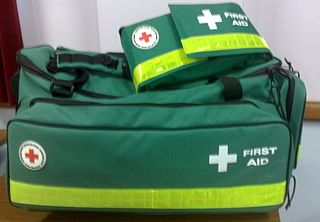
A first aid kit or medical kit is a collection of supplies and equipment used to give immediate medical treatment, primarily to treat injuries and other mild or moderate medical conditions. There is a wide variation in the contents of first aid kits based on the knowledge and experience of those putting it together, the differing first aid requirements of the area where it may be used, and variations in legislation or regulation in a given area.

A bandage is a piece of material used either to support a medical device such as a dressing or splint, or on its own to provide support for the movement of a part of the body. When used with a dressing, the dressing is applied directly on a wound, and a bandage used to hold the dressing in place. Other bandages are used without dressings, such as elastic bandages that are used to reduce swelling or provide support to a sprained ankle. Tight bandages can be used to slow blood flow to an extremity, such as when a leg or arm is bleeding heavily.

An orthopedic cast, or simply cast, is a shell, frequently made from plaster or fiberglass, that encases a limb to stabilize and hold anatomical structures—most often a broken bone, in place until healing is confirmed. It is similar in function to a splint.
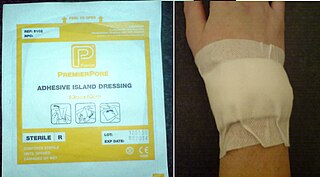
A dressing or compress is piece of material such as a pad applied to a wound to promote healing and protect the wound from further harm. A dressing is designed to be in direct contact with the wound, as distinguished from a bandage, which is most often used to hold a dressing in place. Modern dressings are sterile.

Venous ulcer is defined by the American Venous Forum as "a full-thickness defect of skin, most frequently in the ankle region, that fails to heal spontaneously and is sustained by chronic venous disease, based on venous duplex ultrasound testing." Venous ulcers are wounds that are thought to occur due to improper functioning of venous valves, usually of the legs. They are an important cause of chronic wounds, affecting 1% of the population. Venous ulcers develop mostly along the medial distal leg, and can be painful with negative effects on quality of life.
A traction splint most commonly refers to a splinting device that uses straps attaching over the pelvis or hip as an anchor, a metal rod(s) to mimic normal bone stability and limb length, and a mechanical device to apply traction to the limb.
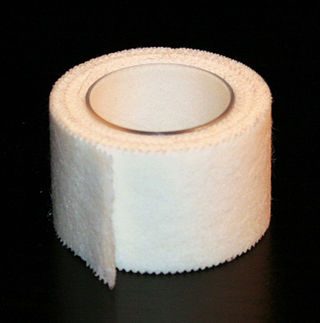
Surgical tape or medical tape is a type of pressure-sensitive adhesive tape used in medicine and first aid to hold a bandage or other dressing onto a wound. These tapes usually have a hypoallergenic adhesive which is designed to hold firmly onto skin, dressing materials, and underlying layers of tape, but to remove easily without damaging the skin. They allow air to reach the skin ("breathable"). Some breathable tapes such as kinesiology tape, and other elastic bandages with adhesive are made of cotton. Surgical tape is often white because it contains zinc oxide, which is added to help prevent infections. Tapes made of porous material, such as 3M Micropore, are widely used.

A hand wrap or wrist wrap is a strip of cloth used by boxers to protect the hand and wrist against injuries induced by punching. It is wrapped securely around the wrist, the palm, and the base of the thumb, where it serves to both maintain the alignment of the joints, and to compress and lend strength to the soft tissues of the hand during the impact of a punch.
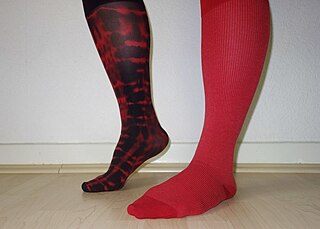
Compression stockings are a specialized hosiery designed to help prevent the occurrence of, and guard against further progression of, venous disorders such as edema, phlebitis and thrombosis. Compression stockings are elastic compression garments worn around the leg, compressing the limb. This reduces the diameter of distended veins and increases venous blood flow velocity and valve effectiveness. Compression therapy helps decrease venous pressure, prevents venous stasis and impairments of venous walls, and relieves heavy and aching legs.
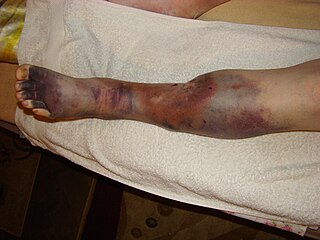
Post-thrombotic syndrome (PTS), also called postphlebitic syndrome and venous stress disorder is a medical condition that may occur as a long-term complication of deep vein thrombosis (DVT).
Cold compression therapy, also known as hilotherapy, combines two of the principles of rest, ice, compression, elevation to reduce pain and swelling from a sports or activity injury to soft tissues and is recommended by orthopedic surgeons following surgery. The therapy is especially useful for sprains, strains, pulled muscles and pulled ligaments.

Buddy wrapping, also called neighbour strapping or buddy taping, is the act of bandaging a damaged or particularly a fractured finger or toe together with a healthy, uninjured one. The bandage or medical tape is usually stiff, not allowing the digits to move; the healthy digit acts as a splint, keeping the damaged one in a natural position for healing. Rest plays a major role in the healing process. Buddy wrapping may also be used for sprains, dislocations, and other injuries.

An Unna’s boot is a special gauze bandage, which can be used for the treatment of venous stasis ulcers and other venous insufficiencies of the leg. It can also be used as a supportive bandage for sprains and strains of the foot, ankle and lower leg. The gauze is impregnated with a thick, creamy mixture of zinc oxide and calamine to promote healing. It may also contain acacia, glycerin, castor oil and white petrolatum.

Jammed finger is a colloquialism referring to a variety of injuries to the joints of the fingers, resulting from axial loading beyond that which the ligaments can withstand. Common parts of the finger susceptible to this type of injury are ligaments, joints, and bones. The severity of the damage to the finger increases with the magnitude of the force exerted by the external object on the fingertip. Toes may become jammed as well, with similar results.
A compartment syndrome is an increased pressure within a muscular compartment that compromises the circulation to the muscles.

Elastic therapeutic tape, also called kinesiology tape or kinesiology therapeutic tape, Kinesio tape, k-tape, or KT is an elastic cotton strip with an acrylic adhesive that is purported to ease pain and disability from athletic injuries and a variety of other physical disorders. In individuals with chronic musculoskeletal pain, research suggests that elastic taping may help relieve pain, but not more than other treatment approaches, and no evidence indicates that it can reduce disability in chronic pain cases.

Athletic taping is the process of applying tape directly to the skin or over pre-wrap in order to maintain a stable position of bones and muscles during athletic activity. It is a procedure that uses athletic tape, attached to the skin, to physically hold muscles or bones at a certain position. This reduces pain and aids recovery. Taping is usually used to help recover from overuse and other injuries.
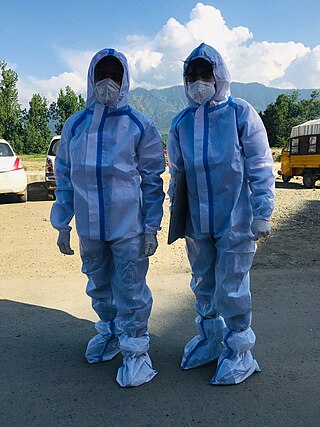
Medical textiles are numerous fiber-based materials intended for medical purposes. Medical textile is a sector of technical textiles that emphasizes fiber-based products used in health care applications such as prevention, care, and hygiene. The spectrum of applications of medical textiles ranges from simple cotton bandages to advanced tissue engineering. Common examples of products made from medical textiles include dressings, implants, surgical sutures, certain medical devices, healthcare textiles, diapers, menstrual pads, wipes, and barrier fabrics.

















